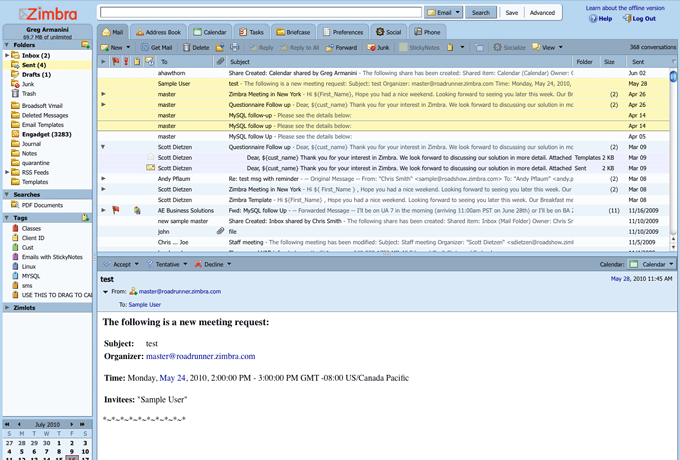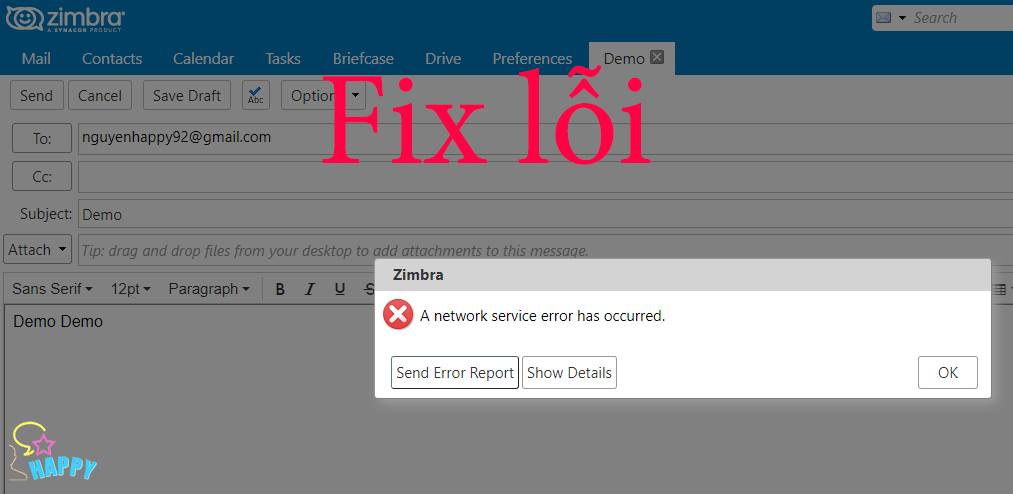
- Zimbra desktop a client error occured how to#
- Zimbra desktop a client error occured manual#
- Zimbra desktop a client error occured password#
But once login is not successful - cannot find ability to link it to particular account, to account failed ones. Once again, once login is successful, activity can be seen in different places, but at some point it's hard to link it to particular account.
Zimbra desktop a client error occured how to#
But cannot find how to count wrong logins for particular account via web UI. What I want to achieve, is pick logs, and find IP addresses and account names, that get false authentication - penetration, brute force, etc. There should be something, or how does Zimbra count unsuccessfull logins, including web ui, to introduce automatic lockout? Or, I can identify IP address (if URI filtering could be reliable), that missed web ui login, but cannot relate it to particular account.Īt this point I'm stuck. You may have to add the certificate to javas keyring cacerts, which is located in zimbra/java/jre/lib/security/cacerts and can be modified using the 'keytool' command. Probably because of a self signed or old certificate. Local logs containing Zimbra activity are in the /opt/zimbra/logdirectory. 1 Answer Sorted by: 1 I think, Zimbras java is rejecting your servers certificate. The logs described below are the primary logs that are used for analysis and troubleshooting. Contacts?.), but this at particular timestamp, may be related to any other sessions, that at single point of time might have success in auth. ZCS logs its activities and errors to a combination of system logs through the syslog daemon as well as Zimbra specific logs on the local file system. For more information on setting the Sync Token, see. Set the Sync Token to an earlier Sync Token number, and attempt to resync the user’s mailbox. To do this, have the user create another profile, open Outlook, and click Tools>Send/Receive>Send/Receive All to sync with the Zimbra server. No related info in audit.log nor mailbox.log according to session ID.: Choose to force an initial sync of the user’s mailbox. The difference between failed and success POST event (further only static resources loaded, added sessinon ID, but I cannot find, if there's any use of session ID. But no user account at this point available, as well, as I cannot warranty, that tailing URIs are the right way to watch logs. The only way to find out, that somebody is trying to guess web ui pass, or trying to penetrate login form, is to follow POST requests in Nginx (Zimbra Proxy) log files, which do give sign of difference. No auth errors in mailbox.log, nor audit.log files.
Zimbra desktop a client error occured password#
Now, what I was looking for - there are no signs of wrong web ui password entry. This helps a little, as we can distinguish oip, but not very much, if users are logging on via NATted network and single gateway IP. Yet, there's no option to tie together Nginx and mailbox.log data to a single account, as during a second, there may be several authentications to different accounts. But that's in case, we have rare authentication events. Yet, in Nginx log, there's a POST event, corresponding to event in mailbox.log, during /service/soap/AuthRequest. Regarding AuthRequests - I cannot find information, what's the last element in log entry - 'elapsed=X', where X is numbers.Īnd the opposite - during logout, there's a notice about /service/soap/EndSessionRequest.īy this, I may catch the fact, that user has successfully authenticated, and due to activity in mailbox.log and proxy server /nginx.log timestamps gather activity, that some resources get downloaded (img, css, js, etc.). Assuming this, such log entry can be used just to track, that user has successfully logged in and from which IP address, User agent, etc. Amongst them - there are /service/soap/AuthRequest requests, indicating external oip and user name. When auth is successfull, there's a bunch log entries to /service/soab/GetInfoRequest. Watch the video tutorial to know the exact step-by-step procedure through a video guide, which will help you complete the process more effectively, or you may also find mistakes if you commit while going through the process.Thank you Rich, for hint. It will load all the emails with attachments. Now import converted TGZ file into Zimbra Mail using the above option. After completion, open Zimbra Client and click the Import/Export option. Click the Convert button and analyze MBOX to TGZ Conversion process. Select Zimbra as file saving option from the list. Steps to Import MBOX to Zimbra Mail are as follows The benefit of using this method is that it will maintain folder hierarchy, key elements and hold email attachments. This tool is specially developed to upload MBOX emails into Zimbra Desktop application. You can use Advik MBOX Converter for this solution. Efficient Approach to Import MBOX file to Zimbra Mail


So, you can opt for an alternative technique that I am going to discuss in the upcoming sections.
Zimbra desktop a client error occured manual#
However, there is no manual solution is available to transfer MBOX emails to Zimbra. There are no many users who are looking for an easy and direct approach. Today, I am going to explain the step by step process to import MBOX to Zimbra Mail desktop client.


 0 kommentar(er)
0 kommentar(er)
